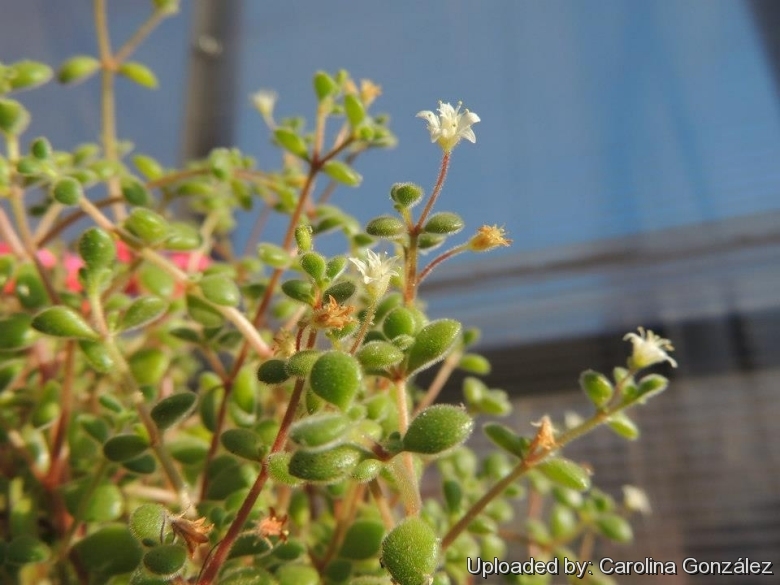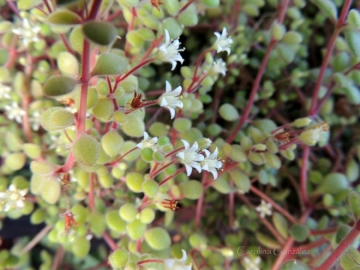Accepted Scientific Name: Crassula expansa subs. fragilis (Baker) Toelken
J. S. African Bot. 41(2): 105 (1975)

Crassula fragilis (Crassula expansa subs. fragilis) Photo by: Carolina González
Origin and Habitat: Crassula expansaSN|30892]]SN|30892]] subsp. fragilis is native to Angola, Mozambique, Zambia, Zimbabwe, Swaziland, Mpumalanga, KwaZulu-Natal and Eastern Cape, South Africa, and Madagascar.
Altitude range: 50-1800 metres above sea level.
Habitat and ecology: This species occurs on rocky slopes in humus-rich pockets in rock crevices mostly in moist shady situations or in bush, riverine forests, or open savanna on termite mounds.
Synonyms:
See all synonyms of Crassula expansa
Description: Crassula expansaSN|30892]]SN|30892]] subsp. fragili is a delicate, untidy, sprawling perennial (or also annual) succulent herb with thin red-brown stems. Its small obovate leaves are hairy or glabrous, with hydathodes scattered on the upper surface. The small tubular white to mottled red flowers are borne in terminal clusters. This taxon shows a wide range of variation particularly in the size and shape of the vegetative organs. Plants vary from densely tomentose to glabrescent, the leaves vary from strongly dorsiventrally compressed to somewhat convex on both surfaces and pedicels elongate in some forms more than in others.
Derivation of specific name: The specific and subspecific epithets, taken from the Latin “expansa”: expanding, spreading and “fragilis”: delicate, fragile, brittle.
Stems: Stems several from a short woody base, up to c. 25 cm long, often purple-brownish below, herbaceous and green above, growing from a short, woody base. Subdichotomously branched, slender, usually puberulous or hispid everywhere (hairs acute, hyaline, spreading, denser and longer above), or sometimes glabrous towards the base, or rarely papillose-puberulous; internodes variable in length, often longer than the leaves.
Leaves: Fleshy when fresh, membranaceous on drying, elliptic, spathulate or obovate, always flat, 3-35(-45) mm long, 2.5-13 mm broad, narrowing into a subpetiolar base, or subsessile, rarely distinctly petiolate, acute or nearly so to obtuse or rounded at the apex, more or less dark green, sometimes with a purple pattern, mostly with short stiff hairs on both faces, rarely glabrous, slightly connate at the base. Hydathodes scattered over the upper leaf surface.
Inflorescences: Terminal thyrses and commonly reduced to a solitary flower in the axils, only one at each node, except for some plants of a form from just north of Pietermaritzpurg, which was described as Crassula woodiiSN|30892]]SN|30908]], where the individual cymules are easily distinguished.
Flowers: 5-merous, white or pale pink, 2-3.5 mm long. Calyx 1.5-2.5(2.75) mm long, green, hispidulous. Sepals linear or linear-lanceolate, obtuse, connate at the base for 0.3-0.6 mm long. Corolla 2.25-3.5 mm long, white or pale pink, petals ovate or oblong-obovate, somewhat contracted towards the obtuse apex, smooth, with the median nerve hispid outside. Filaments 1.25-2.25 mm long. Anthers 0.25-0.5 mm long. Styles 0.25-1 mm long. Indumentum present on stem, leaves. Pedicels filiform, elongating in fruit up to 30(35) mm.
Blooming season: Flowering is usually dependent on rains but can be from November to January in most regions.
Fruits (follicles): 2.25-3 mm long.
Seeds: Finely covered with short rough points .
Similar species: Crassula expansaSN|30892]]SN|30892]] subsp. fragili is similar to Crassula expansaSN|30908]]SN|30892]] subsp. expansa but differing in the following characters: habit usually procumbent, with thicker, longer stems and branches; leaves thinner, always flat, larger and relatively broader; hydathodes scattered over the upper leaf surface. Calyx, filaments, anthers and follicles usually a little longer than in Crassula expansaSN|30892]]SN|30892]].
Subspecies, varieties, forms and cultivars of plants belonging to the Crassula expansa group
 Crassula expansa Dryand.: The typical subspecies has decumbent branches with glabrous leaves and no 'stilt' roots. Distribution: Dry regions of Namaqualand to coastal forest in KwaZulu-Natal.
Crassula expansa Dryand.: The typical subspecies has decumbent branches with glabrous leaves and no 'stilt' roots. Distribution: Dry regions of Namaqualand to coastal forest in KwaZulu-Natal.- Crassula expansa subs. filicaulis (Haw.) Toelken: is slightly woody with glabrous leaves and develops 'stilt' roots. Distribution: coastal dunes from Port Alfred in the eastern Cape to the Cape Peninsula.
 Crassula expansa subs. fragilis (Baker) Toelken: has hairy or glabrous leaves, with hydathodes scattered on the upper surface. Distribution: Angola, Mozambique, Zambia, Zimbabwe, Swaziland, Mpumalanga, KwaZulu-Natal and Eastern Cape, South Africa, and Madagascar.
Crassula expansa subs. fragilis (Baker) Toelken: has hairy or glabrous leaves, with hydathodes scattered on the upper surface. Distribution: Angola, Mozambique, Zambia, Zimbabwe, Swaziland, Mpumalanga, KwaZulu-Natal and Eastern Cape, South Africa, and Madagascar.- Crassula expansa subs. pyrifolia (Compton) Toelken: has glabrous leaves with hydathodes scattered over the entire surface, flowers in terminal clusters. Distrbution: sand in the coastal belt from Namaqualand to south-western Namibia.
Bibliography: Major references and further lectures
1) Dr J.P. Roux “Flora of South Africa” (2003)
2) R. Fernandes “Flora Zambesiaca” Vol 7, Part 1, Pages 14 - 15. as Crassula fragilis, (1983)
3) “Crassula expansa subsp fragilis” in Tolken in Jl S. Afr. Bot. 41: 105 (1975)
4) “Crassula expansa subsp fragilis” Wickens & By-water in Kew Bull. 34: 635 (1980).
5) David Hardy, Anita Fabian, Gerrit Germishuizen “Succulents of the Transvaal” Southern Book Publishers, 1992
6) Hyde, M.A., Wursten, B.T., Ballings, P. & Coates Palgrave, M. (2015). "Flora of Zimbabwe: Species information: Crassula expansa subsp. fragilis var. fragilis."
http://www.zimbabweflora.co.zw/speciesdata/species.php?species_id=125080, retrieved 28 March 2015
7) Doreen Court “Succulent Flora of Southern Africa” CRC Press, 01 June 2000
8) Da Silva, M.C., Izidine, S. & Amude, A.B. (2004). "A preliminary checklist of the vascular plants of Mozambique." Southern African Botanical Diversity Network Report No. 30 Sabonet, Pretoria Page 49.
9) Fabian, A. & Germishuizen, G. “Wild Flowers of Northern South Africa.” Fernwood Press, Vlaeburg. Pages 154 - 155. (Includes a picture).(1997).
10) Mapaura, A. & Timberlake, J. (eds) “A checklist of Zimbabwean vascular plants” Southern African Botanical Diversity Network Report No. 33 Sabonet, Pretoria and Harare Page 37. (2004).
11) Phiri, P.S.M. “A Checklist of Zambian Vascular Plants Southern African” Botanical Diversity Network Report No. 32 Page 44. (2005).
12) Pooley, E. ”A Field Guide to the Wild Flowers of KwaZulu-Natal and the Eastern Region.” Natal Flora Publications Trust. Durban. Pages 144 - 145. (Includes a picture). (1998).
13) Énum. Pl. Fleurs Afr. Trop. 1: 73 (1991).
 Crassula fragilis (Crassula expansa subs. fragilis) Photo by: Carolina González
Crassula fragilis (Crassula expansa subs. fragilis) Photo by: Carolina González Crassula fragilis (Crassula expansa subs. fragilis) Photo by: Carolina González
Crassula fragilis (Crassula expansa subs. fragilis) Photo by: Carolina GonzálezCultivation and Propagation: Crassula expansa subs. fragilis loves heat and is easy to root and grow. It thrive with bright light and ample airflow. The leaves on this succulent can either appear as bright apple green or flaming red. It makes a nice groundcover in subtropical climates and is drought tolerant and only want light watering. This plant is almost indestructible, does not require any care... no care at all, it will grow. Sure it like water, but it is very drought tolerant... ... throw it on the trash piles and it just keeps growing and flowering, it looses easily its leaves that will root and grow new plants everywhere.
Growth rate: Moderately fast (bordering on invasive!) plant for the garden.
Soil: It grows best in sandy-gritty soil. Good drainage is very important as it is prone to root rot.
Repotting: Repot every two years in spring. Do not radically cut off roots: about 10 percent of the root ball is right.
Fertilization: Feed it from mid spring to early autumn every four or five weeks with a fertilizer specifically formulated for cactus and succulents (poor in nitrogen), including all micro nutrients and trace elements diluted to ½ the strength recommended on the label. Do not feed plants during winter.
Watering Needs: It is a dry-tolerant plant. Water regularly in the growing season, but avoid water-logging and let dry between waterings. Water with caution in winter, as the plant can lose its roots if the soil stays cold and wet for extended periods. The lower the temperature the less water is needed. If grown in a container, bottom watering by immersing the container is recommended. Mist spraying is not needed, it must have very dry atmosphere.
Sun Exposure: Does well in filtered sun, but can handle some shade, too. In shade the leaves colour will remain more green, while in harsh full sun conditions the foliage can develop a pinkish tinge. In summer keep cool and provide some shelter from direct sun during the hottest hours. It can be sunburned if moved from shade/greenhouse into full sun too quickly. It tends to get leggy in deep shade.
Frost Tolerance: Protect from frost to prevent scarring. It requires a minimum temperature of about 5°C, but will take a light frost and is hardy down to -5° C for short periods if it is in dry soil. USDA zones 9A – 11. In areas prone to frost, grow in an intermediate greenhouse or conservatory, in pots. The plant may be kept indoors throughout the year at a minimum winter temperature of 10°C not exceeding 18°C. In summer, the temperature will rise higher, but as this is accompanied by better light it does not matter. In colder climates plant this in a container, so it can be moved into a protected area when cold.
Garden uses: They make wonderful rocker plants in hot, dry areas and also grow well in containers or luminous patios. These crassula plants are great for hanging baskets too.
Pests and diseases: May be susceptible to mealybugs and rarely scale. Protect from cold. Occasionally suffers from foliage edema which is thought to be the result of rapid changes in available moisture.
Maintenance: At the end of summer plants get quite long-shanked with dried flowering stalk and so is a good time of year to trim them back substantially.
Propagation: From seed but it is easily increased by cuttings. Cuttings root easily. It is also possible, to plant the leaves in good, sandy soil where they will take root - members of this family often propagate vegetatively in this way. Take leaf cuttings in spring and summer. Detach a leaf from an established plant by pulling or bending, and leave it to dry for a day. Insert the broken end of the leaf into a mix of one part slightly moist peat and two parts sharp sand Firm the mix around the bases of each cut-ting, which will later grow roots. The leaf cutting can then be repotted.












